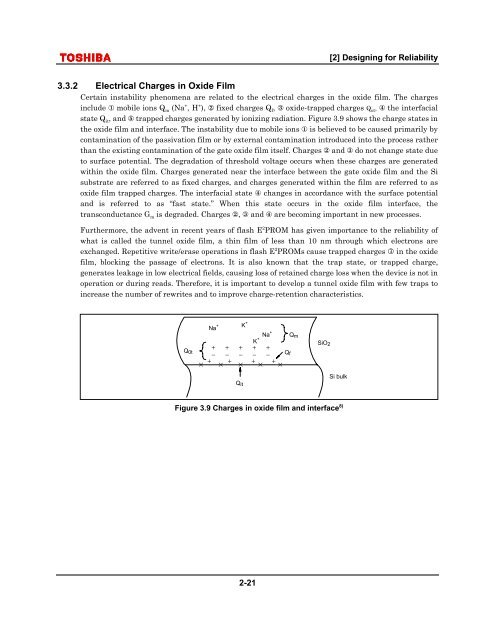1. Basic Concepts in Reliability Design - nl3prc
1. Basic Concepts in Reliability Design - nl3prc
1. Basic Concepts in Reliability Design - nl3prc
You also want an ePaper? Increase the reach of your titles
YUMPU automatically turns print PDFs into web optimized ePapers that Google loves.
[2] <strong>Design</strong><strong>in</strong>g for <strong>Reliability</strong>3.3.2 Electrical Charges <strong>in</strong> Oxide FilmCerta<strong>in</strong> <strong>in</strong>stability phenomena are related to the electrical charges <strong>in</strong> the oxide film. The charges<strong>in</strong>clude 1 mobile ions Q m (Na + , H + ), 2 fixed charges Q f , 3 oxide-trapped charges Q ot , 4 the <strong>in</strong>terfacialstate Q it , and 5 trapped charges generated by ioniz<strong>in</strong>g radiation. Figure 3.9 shows the charge states <strong>in</strong>the oxide film and <strong>in</strong>terface. The <strong>in</strong>stability due to mobile ions 1 is believed to be caused primarily bycontam<strong>in</strong>ation of the passivation film or by external contam<strong>in</strong>ation <strong>in</strong>troduced <strong>in</strong>to the process ratherthan the exist<strong>in</strong>g contam<strong>in</strong>ation of the gate oxide film itself. Charges 2 and 3 do not change state dueto surface potential. The degradation of threshold voltage occurs when these charges are generatedwith<strong>in</strong> the oxide film. Charges generated near the <strong>in</strong>terface between the gate oxide film and the Sisubstrate are referred to as fixed charges, and charges generated with<strong>in</strong> the film are referred to asoxide film trapped charges. The <strong>in</strong>terfacial state 4 changes <strong>in</strong> accordance with the surface potentialand is referred to as “fast state.” When this state occurs <strong>in</strong> the oxide film <strong>in</strong>terface, thetransconductance G m is degraded. Charges 2, 3 and 4 are becom<strong>in</strong>g important <strong>in</strong> new processes.Furthermore, the advent <strong>in</strong> recent years of flash E 2 PROM has given importance to the reliability ofwhat is called the tunnel oxide film, a th<strong>in</strong> film of less than 10 nm through which electrons areexchanged. Repetitive write/erase operations <strong>in</strong> flash E 2 PROMs cause trapped charges <strong>in</strong> the oxidefilm, block<strong>in</strong>g the passage of electrons. It is also known that the trap state, or trapped charge,generates leakage <strong>in</strong> low electrical fields, caus<strong>in</strong>g loss of reta<strong>in</strong>ed charge loss when the device is not <strong>in</strong>operation or dur<strong>in</strong>g reads. Therefore, it is important to develop a tunnel oxide film with few traps to<strong>in</strong>crease the number of rewrites and to improve charge-retention characteristics.Q 0tNa + K+ Na + Q mK ++ + + + +− − − − − Qf+ + + +× × × × ×SiO 2Si bulkQ itFigure 3.9 Charges <strong>in</strong> oxide film and <strong>in</strong>terface 8)2-21





